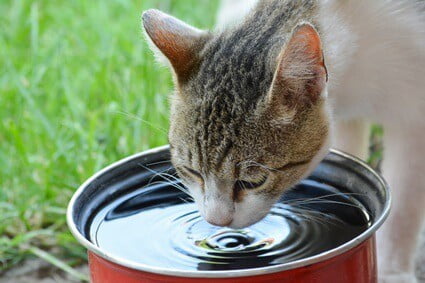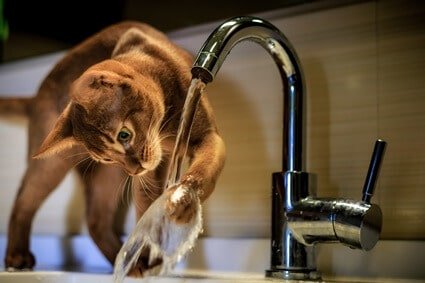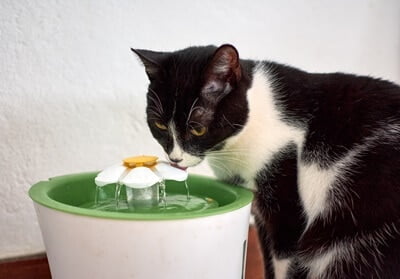Cats are desert-dwelling animals that get most of their water from their food. They don’t need to drink water as frequently as dogs, but they can still get dehydrated. That’s especially true if your cat mainly eats dry food and refuses its water bowl. If so, you need to take steps to ensure that your cat stays hydrated.
To get your cat to drink more water, move its water farther away from its food. You can also get a water fountain, use bowls of different materials (avoiding plastic), and place water bowls in several different places around the house. If your cat still refuses, offer broth instead, switch to wet food, and add water to cat food.
You’ll know your cat is dehydrated if its skin tents, it shows a loss of appetite, or it seems lethargic. If it’s been vomiting or has diarrhea, this can quickly result in dehydration. Look out for sunken eyes, panting, sticky gums, and less urination. If you find these signs, then you’ll need to encourage your cat to drink water without delay.
How Much Water Should a Cat Drink?
Your cat requires roughly 3.5 to 4.5 ounces of water for every 5 pounds of body weight, and this should be consumed each day to stay hydrated and healthy.
For example, a 10-pound cat will need 7 to 9 ounces of water per day. If the cat consumes water through wet food or broths, it may not drink much water from the bowl.
About 80% of wet food is water in most cases, which means your cat will hardly drink any water from its bowl.
How To Get Your Cat To Drink More Water
According to the Journal of General Psychology, cats are not thirst-driven.
However, like any creature, they still need to drink water. If you’re concerned that your cat isn’t staying properly hydrated, you may need to make some adjustments.
Here are some ways to get a cat to drink water:
1/ Move the Water Bowl Away From Food
Some cats dislike having their water near their food, as they fear contaminating the water with their meals. If the water bowl is directly next to the food, try moving it to another area so that the cat feels more comfortable taking a drink.
However, some cats are more curious and are likely to inspect the water and take a sip while eating. Putting water near the meal increases the likelihood of the cat alternating between eating and drinking.
If the water bowl is placed far away from the dish, try moving it closer (or vice versa).
2/ Water Fountain
Filtered water fountains can pique the interest of cats in hydrating.
Some cats enjoy the sound of running water, and the filter keeps the water fresh for longer. Maintaining the filter regularly is important since germs can build up and prevent your cat from drinking.
Some cats prefer running water even more than fountains. Therefore, turning on a faucet at a slow drip (if there is no water scarcity) for periods of time when your cat is active helps if your cat turns down the fountain.
It’s even known for cats to drink from the toilet bowl.
3/ Different Bowls
Some cats are picky about their water dishes and will avoid drinking for this reason alone. As such, try experimenting with different bowl materials to determine which one your cat prefers.
Glass, stainless steel, and ceramic are favorable options because they don’t retain smells. Cats often avoid plastic because it can gradually smell like mildew, mold, or bacteria, even if regularly cleaned.
Also, some cats develop allergic reactions to plastic drinking vessels.
4/ Water Access in Different Places
Cats are naturally curious animals, so take advantage of this curiosity by providing water in various locations throughout your home.
This will not only encourage the feline to hunt for its water like it would search for fresh water in the wild. It will also make each bowl a new and interesting object the cat is unfamiliar with.
Try placing a bowl in the corner of the living room or the bedroom. By making each bowl a different shape or material, you can make them even more interesting.

5/ Increased Access to Water
You may own a lazy cat or one with a severely limited thirst drive.
The feline may not want to take the time to wander to a specific place to find water. By making water readily available and thus easy to find, you’re encouraging the cat to drink more often.
Place multiple water bowls in various spots throughout your home so that your cat will have constant access to water. This simple trick can encourage them to drink more throughout the day.
You can even set the dry food in a timed feeder and keep a dish of water nearby. Because the water is readily available while the cat is waiting for food, the cat may drink more of it while waiting.
6/ Fill the Bowl To The Brim
Whiskers on cats are extremely sensitive to touch.
Some cats don’t enjoy it when their whiskers come into contact with the edge of their bowl. Therefore, filling the water bowl almost to the brim may encourage some cats to drink more water in the future.
7/ Add Broth To Your Cat’s Diet
If your cat doesn’t like plain water, try substituting it with broth.
This adds flavor and nutrients to your cat’s diet while also keeping it hydrated. Picky eaters will be more likely to give this drink a try, and other cats won’t be able to resist.
Just be sure that the broth is organic and contains no additives, such as salt or preservatives. Likewise, check with your vet before using this option if your cat has any weight issues or is experiencing health problems.
As long as your cat is in good health and isn’t overweight, the added nutrients can even improve its energy levels, coat, and bone strength.
You can serve a beef or bone broth once or twice a day. Dry broths that rehydrate by adding warm water are also readily available at grocery stores.

8/ Wet Food
In the wild, cats get most of their water from their food.
You can replicate this at home by offering your cat wet food. The moisture in wet food will keep your cat hydrated without requiring it to drink plain water.
According to CatInfo, a cat on a dry-food diet drinks more regular water than a cat on a canned-food diet. However, the total amount of water consumed by the dry-food cat is only about half that of the canned-food cat, when all water sources are included.
If your cat eats dry food exclusively, this transition may cause digestive issues. To avoid that, gradually incorporate wet food into the diet.
If your cat is used to free-feeding dry food, increase the number of meals to3-4 per day before introducing wet food. Then, allow your cat to know when it’s time to eat by leaving the food out for 20 minutes before taking it away.
You can start giving your cat wet food once it’s used to its regular mealtimes. Some cats will take to wet food immediately, while others will take a little longer.
If your cat refuses to eat wet food, start with a small amount mixed in with your cat’s dry food. Then, gradually raise the wet to dry food ratio until your cat only eats wet food.
Add some warm water to dilute the wet food and make it easier to chew.
9/ Modify Dry Food
If your cat is used to eating dry food and isn’t interested in switching to wet food, try mixing water into the kibble.
The kibble will absorb the water and grow softer as a result. For picky eaters, if you add the water in small amounts at a time, your cat may eventually learn to eat the moistened kibble.
If your cat refuses to eat the modified food, continue to provide it with regular dry food rather than allowing it to go hungry. Cats shouldn’t go for more than a day without a meal as it starts to adversely affect their health.
10/ Syringe
If your cat is sick or severely dehydrated, it may stop drinking or eating from its bowls altogether. If so, you may use a syringe to give the cat some clean, room-temperature water.
Syringe the water into the cat’s mouth and allow it to swallow. Keep in mind that it may fight you, so you might need to wrap the cat in a towel first. If things have gotten this dire, you’ll need to contact your vet.
Aside from room-temperature water, you can give your cat electrolyte solution if it’s not drinking water or is somewhat dehydrated. Around 2 to 4 milliliters for every pound of body weight should be given every 2-4 hours.


My new kitten doesn’t drink water which is worrying. I know milk is not good so i dilute a bit in water to get some liquid in her.
She eats wet and dry food